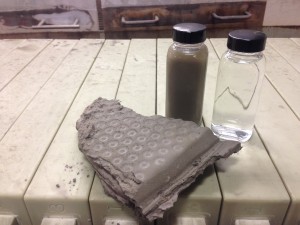 Plate Size
Plate Size
Once the cubic foot capacity of a filter press has been determined the next step is, the proper selection of the size of the filter plates, frame, components and any accessories. This will allow you to see exactly where the cu. ft. capacity fits in relation to the volume of each size press. For example a 5 cu. ft. can be sized as a 470 mm, a 630 mm and also an 800 mm. The size selected is determined by the amount of expandability desired. After the plate size is selected, there are many options from which to choose. The following information is a summary of what needs to be considered in order to make the proper selection, Please read each section in turn and note your requirements.
Plate Construction
Select the type of filter plate material. The standard material is an industrial grade polypropylene. An optional FDA approved food grade polypropylene material, or a high temperature glass filled polypropylene material are also available. Special materials are also available such as Carbon Steel , Stainless steel and Kynar.
Plate Style
The standard is a 100 psi recessed gasketed plate with EPDM seals. Viton seals are available as an option. Also available are non-gasketed plates with quick removal latex edged cloths, where the cloth acts as the gasket. The Non gasketed plates allow for easier change out of the filter cloth, are lower in cost, but are not completely liquid tight during the processing stage. Special membrane squeeze plates have the ability to expand after the chambers are full to “squeeze” additional process liquid out of the filter cake. A “mixed stack” of plates will be provided where every other plate will be a special membrane squeeze plate
Optional Backing Plate
If a shorter cycle is desired, when running low volume applications for example, the capacity of the filter press can be temporarily reduced. This is done by moving the follower (tail) plate forward in the plate stack. The backing or “blank plate” is then placed behind the follower plate acting as extra support. The follower plate will not flex or break when used in this manner.
Plate and Press Pressure Rating
The 100 psi design is standard for most dewatering applications and will produce a cake with approximately 30-35% solids. A 225 psi design can be used to provide an increased yield per cycle and depending on the application can increase the solids in the cake to 50% or more.
 Cake Thickness
Cake Thickness
The 32 mm cake thickness is standard. Options include 25, 38 and 50 mm cake thickness. 25 mm would be used for high viscosity (slimy) materials and 50 mm would be used for easily filtered material.
Cloth Type
ErtelAlsop can provide filter cloths in many different materials, weaves, thread styles, and air permeability values resulting in a wide array of performance characteristics. If possible ErtelAlsop would like to receive samples of the process liquid to conduct filterability tests for cloth selection. If testing is not possible then we will furnish our standard polypropylene filter cloth, a monofilament x multifilament, Sateen weave with a CFM<1.0.
Frame Design
All ErtelAlsop frame configurations are sidebar design. Frames can be designed in Carbon Steel or Stainless Steel.
Volume of Plates/Expansion Spacer
All filter presses are available with optional removable expansion spacer. On presses ordered with a spacer, the first number denotes current plate capacity. The second number in the nomenclature is the maximum capacity the frame will allow.
Discharge/Air Blow-down Piping
The discharge/air blow-down piping is available in either manual or in automatic operation. An optional core blow-down is available to purge the center feed line of residual fluid. Available materials of construction are schedule 80 CPVC, or schedule 40 Stainless Steel.
Feed Style
The feed style can vary for special applications such as pharmaceuticals and some type of food processing. Center feed is standard, however a choice of any corner feed is available.
Automation versus Manual Operation
Manual or semi automatic operation requires input from an operator to start and operation of the filter press, including opening and closing, blow down, plate shifting etc. Fully automated presses require initial start up of operation and then close fill, blow-down, plate shift, discharge and cloth wash is automated. Restarting the press cycle still requires operator input.
EA 102 & EA 203 Filter Press – 102 mm & 203 mm, bench top, laboratory filter press
EA 470 & EA 630 Filter Press – 470 mm & 630 mm
EA 800 & EA 1000 Filter Press – 800 mm & 1000 mm
EA 1200 & EA 1500 Filter Press – 1200 mm & 1500 mm
- Sludge Dewatering
- Municipal Sludge
- Waste Stream Remediation
- Precious Metal Recovery
- Environmental Remediation
- Desalinization Filtration
- Biodiesel Dry Wash Separation
- Ethanol Filtration
- Ore Sludge Processing
